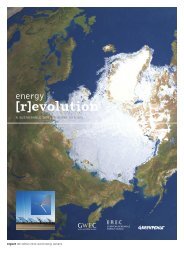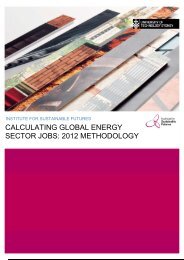download the mexico energy revolution scenario
download the mexico energy revolution scenario
download the mexico energy revolution scenario
Create successful ePaper yourself
Turn your PDF publications into a flip-book with our unique Google optimized e-Paper software.
WORLD ENERGY [R]EVOLUTION<br />
A SUSTAINABLE ENERGY OUTLOOK<br />
figure 7.2: ranges of potential for different<br />
biomass types<br />
figure 7.3: bio <strong>energy</strong> potential analysis from<br />
different authors<br />
(‘EFFICIENCY’ = REDUCTION COMPARED TO THE REFERENCE SCENARIO)<br />
7<br />
<strong>energy</strong> sources and security of supply | POTENTIAL OF ENERGY CROPS<br />
no year 2020-30 2050 2100<br />
<strong>energy</strong> crops<br />
residues<br />
<strong>energy</strong> crops<br />
annual forest growth<br />
animal residues<br />
forest residues<br />
crop residues<br />
<strong>energy</strong> crops<br />
animal residues<br />
forest residues<br />
crop residues<br />
<strong>energy</strong> crops<br />
residues<br />
<strong>energy</strong> crops<br />
annual forest growth<br />
potential of <strong>energy</strong> crops<br />
0 200 400 600 800 1,000 1,200 1,400<br />
source GERMAN BIOMASS RESEARCH CENTRE (DBFZ)<br />
EJ/yr<br />
Apart from <strong>the</strong> utilisation of biomass from residues, <strong>the</strong> cultivation<br />
of <strong>energy</strong> crops in agricultural production systems is of greatest<br />
significance. The technical potential for growing <strong>energy</strong> crops has<br />
been calculated on <strong>the</strong> assumption that demand for food takes<br />
priority. As a first step <strong>the</strong> demand for arable and grassland for<br />
food production has been calculated for each of 133 countries in<br />
different <strong>scenario</strong>s. These <strong>scenario</strong>s are:<br />
• Business as usual (BAU) <strong>scenario</strong>: Present agricultural activity<br />
continues for <strong>the</strong> foreseeable future<br />
• Basic <strong>scenario</strong>: No forest clearing; reduced use of fallow areas<br />
for agriculture<br />
• Sub-<strong>scenario</strong> 1: Basic <strong>scenario</strong> plus expanded ecological<br />
protection areas and reduced crop yields<br />
• Sub-<strong>scenario</strong> 2: Basic <strong>scenario</strong> plus food consumption reduced<br />
in industrialised countries<br />
• Sub-<strong>scenario</strong> 3: Combination of sub-<strong>scenario</strong>s 1 and 2<br />
In a next step <strong>the</strong> surpluses of agricultural areas were classified<br />
ei<strong>the</strong>r as arable land or grassland. On grassland, hay and grass<br />
silage are produced, on arable land fodder silage and Short<br />
Rotation Coppice (such as fast-growing willow or poplar) are<br />
cultivated. Silage of green fodder and grass are assumed to be used<br />
for biogas production, wood from SRC and hay from grasslands for<br />
<strong>the</strong> production of heat, electricity and syn<strong>the</strong>tic fuels. Country<br />
specific yield variations were taken into consideration.<br />
1,400<br />
1,200<br />
1,000<br />
800<br />
600<br />
400<br />
200<br />
EJ/yr 0<br />
Hall et al,<br />
1993<br />
Kaltschmitt<br />
and Hartmann,<br />
2001<br />
Dessus et al<br />
1993<br />
Bauen et al,<br />
2004<br />
Smeets et al,<br />
2007a (low,<br />
own calc.)<br />
No year 2020-30<br />
2050<br />
OECD NORTH AMERICA<br />
OECD EUROPE<br />
OECD PACIFIC<br />
CIS AND NON OECD EUROPE<br />
CARIBBEAN AND LATIN AMERICA<br />
• ASIA<br />
AFRICA<br />
source GERMAN BIOMASS RESEARCH CENTRE (DBFZ)<br />
Smeets et al, Fischer & Fischer &<br />
2007a (high, Schrattenhozer, Schrattenhozer,<br />
own calc.)<br />
2001(low, own 2001(high,<br />
calc.) own calc.)<br />
The result is that <strong>the</strong> global biomass potential from <strong>energy</strong> crops in<br />
2050 falls within a range from 6 EJ in Sub-<strong>scenario</strong> 1 up to 97 EJ<br />
in <strong>the</strong> BAU <strong>scenario</strong>.<br />
The best example of a country which would see a very different<br />
future under <strong>the</strong>se <strong>scenario</strong>s in 2050 is Brazil. Under <strong>the</strong> BAU<br />
<strong>scenario</strong> large agricultural areas would be released by<br />
deforestation, whereas in <strong>the</strong> Basic and Sub 1 <strong>scenario</strong>s this would<br />
be forbidden, and no agricultural areas would be available for<br />
<strong>energy</strong> crops. By contrast a high potential would be available under<br />
Sub-<strong>scenario</strong> 2 as a consequence of reduced meat consumption.<br />
Because of <strong>the</strong>ir high populations and relatively small agricultural<br />
areas, no surplus land is available for <strong>energy</strong> crop production in<br />
Central America, Asia and Africa. The EU, North America and<br />
Australia, however, have relatively stable potentials.<br />
86



![Energy [R]evolution - European Commission](https://img.yumpu.com/49109324/1/184x260/energy-revolution-european-commission.jpg?quality=85)


![5905 gp [eu rev]csfr4.qxd - Energy [R]evolution](https://img.yumpu.com/42305023/1/184x260/5905-gp-eu-revcsfr4qxd-energy-revolution.jpg?quality=85)


![5905 gp [eu rev]csfr4.qxd - Energy [R]evolution](https://img.yumpu.com/28729264/1/184x260/5905-gp-eu-revcsfr4qxd-energy-revolution.jpg?quality=85)